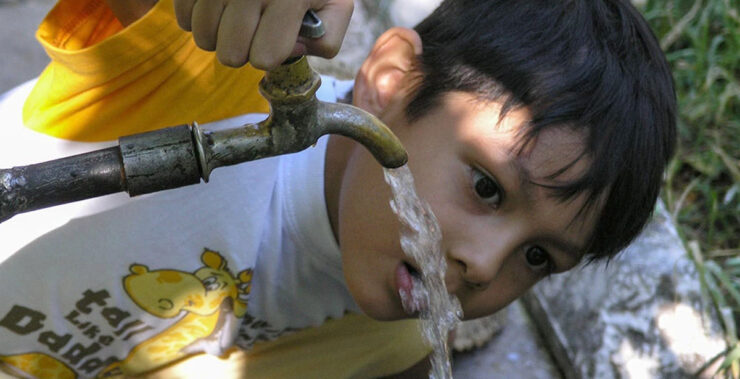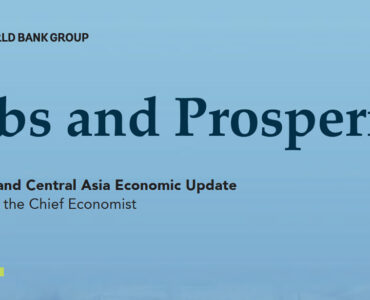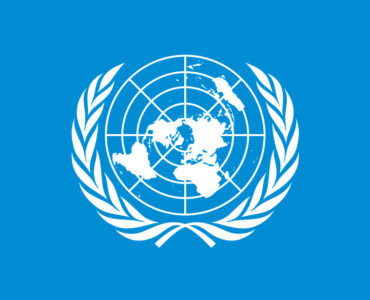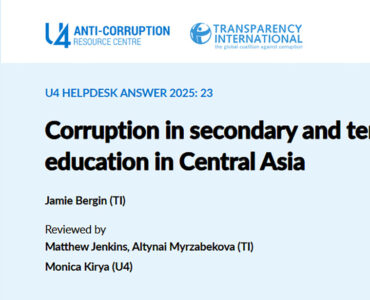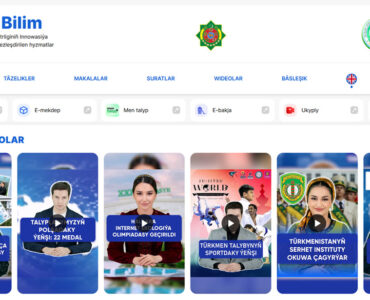Problems such as desertification, water shortage and droughts in Turkmenistan have been covered somewhat in the reports of international organizations. There is limited information available on the state of drinking water in Turkmenistan. The State Committee of the Water Sector is responsible for conducting and implementing state policy concerning operations of water facilities, protection of water resources, provision of water to the population and economic sectors, and improving water resource management.
The Committee has an official website, but data on the state of water resources in the country is not reported, and the news section presents unrelated news articles. According to some sources detailed below, close to 100% of the country’s population have access to basic drinking water and 99% have access to basic sanitation. However, there are discrepancies between what is reported officially by international organizations and the limited academic research and media reports.
Considering low quality of available data as well as high variance in what is available, there is an urgent need for consistent monitoring and reporting of data related to basic drinking water access as well as sanitation. Quality of drinking water has a profound impact on public health. Data on access to safe drinking water is especially important for rural areas, as it is not yet clear whether rural populations have access to safe and centralized water distribution systems. Furthermore, more research is needed in order to reliably and transparently report the assumptions, the definitions, and the methods.
This article provides a summary of the available information on the topic gathered from various open sources.
Reports on access to drinking water by international organizations
There is a variation in reported data on availability of drinking water in Turkmenistan among different sources, partially due to different years reported in identified documents. Several reports either directly related to the drinking water availability or that cover the topic partially, are identified:
- A “National Report of Turkmenistan on Regional Water Partnership” to the Global Water Partnership (the date unclear) claimed that only 60% of the water demand is met in the country, or 438 million m3 out of the total demand of 746.5 million m3 annually. Furthermore, only 30% of the population reportedly receives good water, while 51% do not have satisfactory access to drinking water at all. The same report also raises an issue on inadequate access to sewage systems, as only 44% of the population has access to it, and poor disposal of urban waste outside of the cities pollutes surface and ground waters.
- A study on water related health problems by Bekturganov et al. (2016) has found that about 85% of urban and 42% of rural population in Turkmenistan had access to drinking water. Some people had water-related diseases, with 7955 people diagnosed with intestinal infections, 22 with typhoid, and 4318 with hepatitis virus.
- A 2017 article in the Journal of the Norwegian Medical Association Tidsskriftet also reported water-related issues in the Aral Sea region. Due to the environmental disaster, the lake water composition has changed with salt concentration increasing 10 times, leading to an increased salt concentration in local groundwater to a level 6 times higher than a safety standard by the World Health Organization (WHO). The article reports that in 2000 only 32% of the population in the Aral Sea region had access to safe drinking water. Additionally, water shortages and contamination have been linked to the transmission of diseases such as hepatitis A and diarrhoeal diseases.
- A report by FAOSTAT UN shows a more positive state of affairs. As of 2010, 97% of the urban population in Turkmenistan had access to improved water sources. In rural areas, only 72% of the population had access, as of 2006. The report itself is quite old, dated 2012, and newer reports were not available.
- According to more recent reports, the situation in the country has improved in recent years. The World Bank data reports that 95% of the country’s population is using safely managed drinking water resources, up from 67% in 2000.
- UNICEF MICS also publishes results of surveys on a variety of topics, including on Drinking Water & Sanitation. This report also states that almost 100% of the population has access to basic drinking water, the share of population with only limited and unimproved water was close to 0, and no cases are reported to have no service. “Basic improved drinking water” in this report means water comes from safe sources such as piped water, boreholes or tubewells, protected dug wells, protected springs, rainwater, or packaged water. Additionally, according to the results, 99% of the population has access to basic sanitation (facilities designed to hygienically separate excreta from human contact, e.g. flush to piped sewer system, septic tanks, pit latrines, composting toilets), and less than 1% of the population has a limited sanitation, meaning that the facilities are hygienic but are shared with other households. On a country level, 23% of the population has access to sewer connections, and 77% have access to onsite sanitation. The share of sewer connection is the highest in Ashgabat (93%) and Balkan velayat (49%), but is less than 15% in other regions of the country.
- The Official Statistics website of Turkmenistan also partially publishes data on the completion of Sustainable Development Goals by the United Nations. SDG 6 refers to the access to Clean Water and Sanitation for All. According to the available data, 82.8% of the population had access to safely managed drinking water services in 2016, and the share grew to 99.9% by 2019, since then no updates have been made. Furthermore, one of the indicators of SDG 6 is the share of domestic and industrial wastewater that is safely treated. The shares were very low in 2015-2016, with only 17.5-18.5% of all wastewater being treated, but have since reportedly grown to as high as 60% by 2021. Notably, there has been a decline to 48.7% in 2023. Some data, such as water and sanitation related development assistance by the government or data on new administrative units that promote participation of local communities in water management, is yet to be published.
- In 2015, Global Environment Facility (GEF) initiated a project on Sustainable Water Management in Turkmenistan with a budget over $78 million. The aim of the project was to reduce greenhouse gas emissions from energy use in water management and prevent land degradation. The project proposal document reports that in Balkan velayat, around 50% of the drinking water does not meet hygienic standards, causing frequent water rationing and occurrence of water-borne diseases. The report highlights the rich renewable energy potential in Turkmenistan, that could be used for water pumping and solar or wind-powered desalination to address the water supply issues.
Despite high reported shares of the population with access to safe drinking water and sanitation, the reports in the media are reporting different reality.
For example, in relation to salinity and hardness of drinking water, Eurasianet.org news from 2004 reported that some residents of Turkmenistan only had access to highly saline water. This seemed to be an especially acute problem in Dashoguz Province where only about 20% of people had access to clean drinking water. Furthermore, some estimates have shown that up to 40% of the population in the Aral Sea region (including Dashoguz in Turkmenistan and Khorezm and Karakalpakstan in Uzbekistan) suffered from kidney problems. However, the problem persists in the entire country due to natural salinity levels of Turkmenistan’s groundwater that has to be desalinated. Water from Amu Darya river is also reported to be saline because of the activities of upstream countries (Eurasianet, 2004).
Wide variations in reported data can also be observed when it comes to water availability and water quality. For example:
Donate to support Turkmen analysts, researchers and writers to produce factual, constructive and progressive content in their efforts to educate the public of Turkmenistan.
SUPPORT OUR WORK- Similar to government reports, some news sources have claimed that 99.9% of the population in Turkmenistan has access to water supply services that comply with the safety requirements, the number achieved by investing into water infrastructure, improving water management, and increasing public awareness on the importance of clean water. However, the independent media has reported in 2024 that the water quality in Turkmenabat did not meet the safety standards recommended by WHO, with the water hardness levels reaching 11.3 milligrams of calcium carbonate equivalent per liter.
- At the same time, more news in 2024 have reported and continue to report limited access to water and frequent water cuts across the country. Independent media has reported that tap water has been rationed with some regions getting access to tap water for only one hour in the morning and two hours in the evening in the summer months. In 2022, even residents of Ashgabat have complained about rationing of tap water, further aggravated by not being informed by the local officials. This year there are also reports of deteriorated water quality in the capital city and a neighboring city of Anew. Reportedly, there are tensions among the different consumers of water in the Ahal Velayat.
- Residents in several towns in the Balkan Velayat are left without water and electricity for several days in the scorching sun. Parts of the central city of Turkmenbashi experience day-long water cuts.
- In 2024, there were several water cuts during the Gurban Bayram week alone. Water is cut abruptly without any warning on hot days with 40 plus temperatures. Warnings allow people to stock up on drinking water beforehand and minimizes the risk of people being stranded without water and dying of dehydration.
- The infrastructure in the country is deteriorating. Towns and cities in other velayats face even greater challenges. In Turkmenabad, Lebap, residents are compelled to invest in their own water infrastructure due to persistent water cuts.
Actions taken by the government
The Protocol on Water and Health, adopted in 1999, is a multilateral environmental agreement under the auspices of the United Nations Economic Commission for Europe (UNECE) and the World Health Organization Regional Office for Europe (WHO/Europe). The Protocol focuses on the goal of reaching an adequate supply of safe drinking water and sanitation for everyone, for protection of drinking water sources, and for prevention and reduction of water-related diseases.
The Protocol is a legally binding document for 27 countries that have already ratified it. Uzbekistan acceded to the Protocol at the end of 2023, and Kazakhstan is also considering becoming a member, but Turkmenistan has not yet joined the agreement, despite some workshops organized in the country already in 2015, where possible accession of Turkmenistan to the Protocol was discussed.
Increased water disruptions have led President Serdar Berdimuhamedov to suggest a new system of desalinating water from the Caspian Sea and delivering it to the capital (Radio Liberty, 2022).
Furthermore, a new water treatment plant has been commissioned in Ashgabat in May, 2024. The plant is equipped with a number of filters and treatment steps to ensure that the residents of Ashgabat have a continuous supply of clean drinking water. The plant has a capacity of treating 150 thousand m3 of water per day. Five more plants are in the pipeline this year, one plant in Akhal province (30 thousand m3 of water/day), two plants in Balkan province (50 thousand m3 of water/day in total), and two more in Mary province (a total of 45 thousand m3 of water/day).
Fresh water explorations in the state media
There have also been water resource exploration missions in recent years. One such example is the hydrogeological expedition of the State Corporation “Turkmengeologiya” in the Balkan velayat in 2023. They excavated 6353 meters of wells to find drinking water for the population and agriculture. The expedition led to an increase in water reserves by finding the “Jahangyr” deposit near the city of Gyzylarbat. Furthermore, the water was deemed to be of excellent quality and suitable for drinking and agriculture by the Central Laboratory of “Turkmengeologiya”, but no details on the water hardness level were reported. Similar endeavors are undergoing in other areas near Gyzylarbat (in the mountain gorge at the Purnuar field) and the reserves found there are planned to be used only for drinking purposes.
Earlier expeditions, such as the one reported in 2020 in Dashoguz, discovered drinking water reserves in Uchkepderi field in Gurbansoltan Eje etrap as well as in Dostluk field in the Gubadag etrap. Expeditions in Balkanabat have also revealed new reserves of underground fresh water in the Chukur field in Serdar etrap. According to the reports, these fields were to provide drinking water to rural settlements in the area such as Hajigala, Chukur, Bendesen, and Ajidere.

